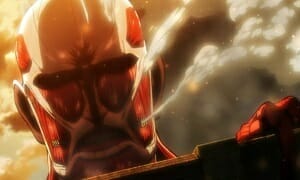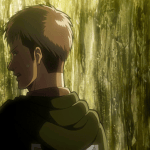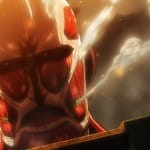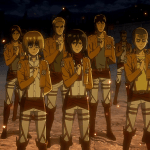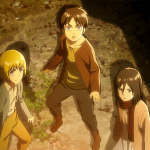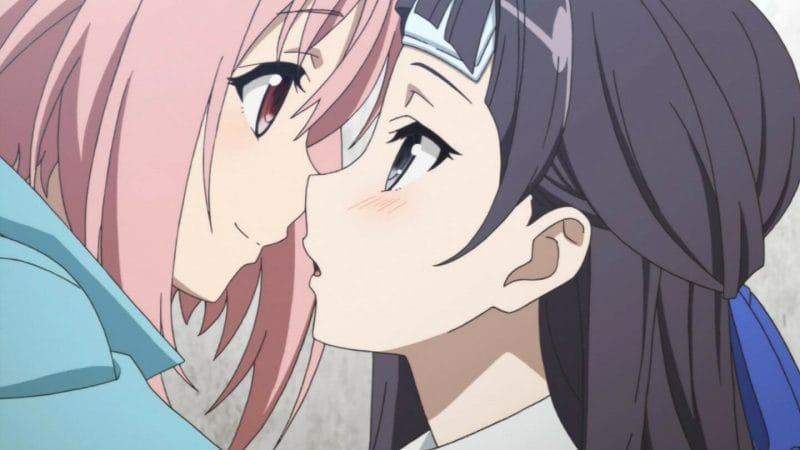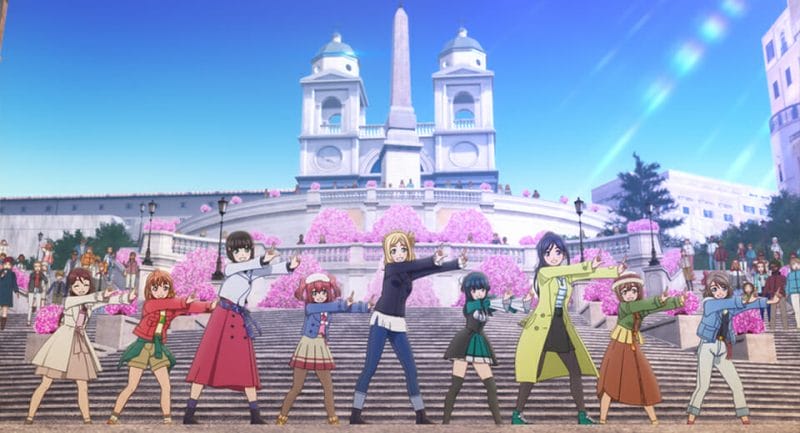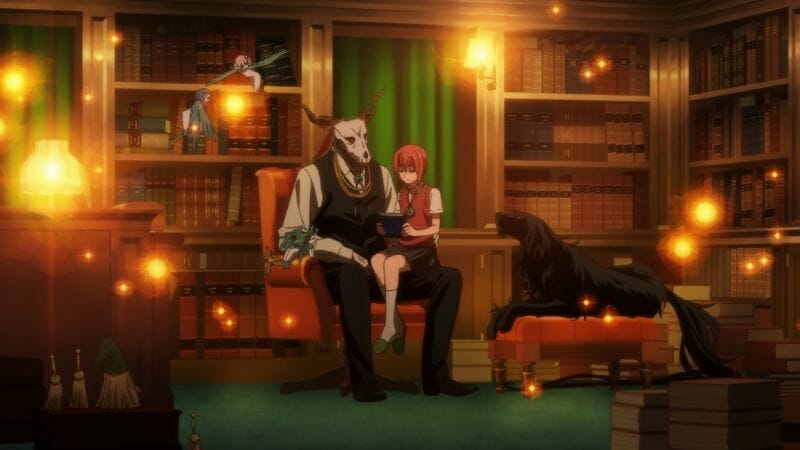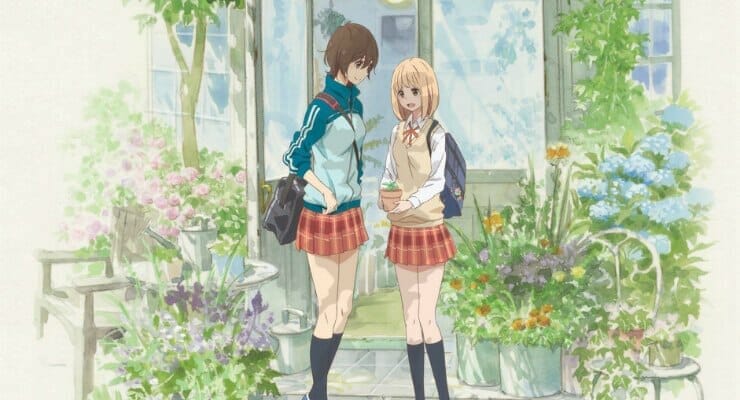US Distributor: FUNimation
Production Studio: Wit Studio
Was this provided by the publisher? No
More Info: Anime News Network
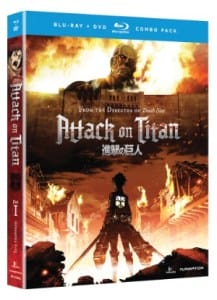 Before the show became an anime darling, I checked out the first two episodes of Attack on Titan. In my impressions, I felt that the show was intriguing. I argued that it did a fantastic job of creating a world of danger and desperation that drew viewers in. Since the show has been completed, I’d like to revisit it to see if it stood up to my initial thoughts.
Before the show became an anime darling, I checked out the first two episodes of Attack on Titan. In my impressions, I felt that the show was intriguing. I argued that it did a fantastic job of creating a world of danger and desperation that drew viewers in. Since the show has been completed, I’d like to revisit it to see if it stood up to my initial thoughts.
Attack on Titan is set in a world where humans live behind gigantic walls to protect themselves from massive humanoid creatures known as “Titans.” The origins of the Titans are unknown, though their hunger for human flesh seems to know no bounds. In the year 850, after 200 years of peace, a “colossal titan” appears out of nowhere and kicks a hole in the wall for the smaller Titans to break through. This invasion forces the citizens to flee and evacuate to the inner city. Many died in the attack, and countless more perished in the famines that followed. Eren Jaeger is one of the affected. After seeing his home destroyed and his mother consumed by the grotesque Smiling Titan, he vows that he will kill every last Titan.
The show’s European-inspired setting is incredibly detailed. It’s a world where the presence of the Titans is always felt as humanity struggles with famine, overpopulation, and a growing divide between the rich and poor. The rich surround themselves with the best and brightest of the military, and have access to luxuries untold of. By contrast, even with a dwindling population, those who live on the outermost wall struggle to survive, and must scrape whatever little they can muster as the elites grow fat and complacent within their own monuments to opulence.
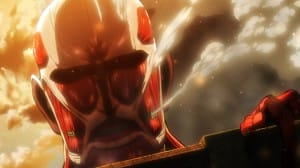
It quickly becomes apparent that even those in the military are seen as dogs in the eyes of the elite. Only the top ten students from any trainee division are granted the luxury of working in the innermost walls, where the easy life awaits. The others, instead, are forced to make a choice. Do they join the Garrison, who protects the towns and repairs the walls, or the Scouting Legion, who boldly venture into Titan territory to reclaim the lands for humanity? Most of the townspeople don’t see the military in a favorable light, either. To some, they are just pigs feeding off of their taxes, while others see them as a beacon of hope that will one day take down the titans.
The leads of the show are strong characters, but tend to fall into familiar archetypes. Armin is the genius, Mikasa’s the bad-ass, and Eren is the overachiever who makes up for his faults through sheer guts. Of the three, I’d say that Armin has the best development, as viewers watch him grow from a sniveling coward into a strategic genius. Throughout various moments in the series Armin uses his smarts to find solutions in bad situations or to deduce what the top brass are plotting. To see Mikasa as the brawn of the group is refreshing, as it’s a role that is usually given to the opposite sex. Unfortunately, her character is hampered by an utter obsession with protecting Eren, to the point that she’d kill herself before admitting that he was ever harmed in any way, shape, or form. Eren, surprisingly, is the least exciting of the core cast in this light. While his passion can move people to action, and his sheer will is endearing, he really doesn’t seem to have the same presence as Armin or Mikasa. Still, each of the three is gifted in some way, and their experiences give valuable insights into their situation. 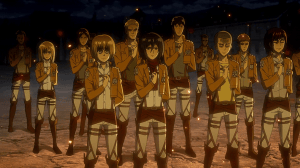
The supporting cast is a different tale. They are more developed and definitely add more dimension to this Titan-filled world. They don’t see much screen time, but they tend to have more “human” emotions and reactions than our leads in certain situations. The secondary cast tends to be the best representation of the world as a whole. They’re scared, angry, hopeful, and prideful. They all have legitimate reasons to follow Eren in joining the scout regiment. They don’t follow the herd mentality, where the main character is right by default. Rather, they see hope with him. They believe that he provides the best, only chance of survival.
Visually, the show sticks to its manga roots. The heavy outlines around the characters give off a comic-like feel. The designs aren’t the most realistic, but they tend to avoid being exaggerated. The details in body designs and faces gives characters a more approachable, “human” appeal. In all my years of life, the Titans rank among the creepiest monsters I have ever seen. Their design is simple, yet horrifying. They look like normal human beings, albeit with strange bodies and sick grins plastered on their faces. Certain Titans, known as “aberrants”, act differently from their normal brethren. For example, one crawls on all fours, and another runs like a prissy girl. The sight may seem silly at first, but these titans quickly prove to be just as unsettling as the standard version. The animation is top-notch, and it doesn’t rely on black screen tricks or cheap speed lines to keep the action fast-paced and exciting. Unfortunately, the transition with many of the 3D environments, especially when characters are swinging around the city, doesn’t always seem to mesh well, leading to a moment of disconnect. This doesn’t ruin the mood, but it can be distracting at times.
If there’s anything that can bring this series down, it would be the melodrama. The show has a habit of kicking viewers into overly long flashbacks at the most inopportune times. For example, during a tense chase scene in the forest, Eren has flashback to training with the scouting regiment during which he almost killed some of his fellow comrades. While these scenes are vital to developing the cast and give context to the dialogue, the timing of several of these moments are odd, and really jerks the viewer out of the scene. Viewers will also notice a pattern concerning the connecting episodes. This pattern is a simple “bad situation gets worse before it gets a little better.” It’s not a bad pattern, but it can grow old if handled incorrectly. The fact that the writers clearly took this pattern and were able to make it seem unpredictable is an incredible feat.
On the surface, Attack on Titan is a show that has a simple “man vs. monster” premise. As it goes on, though, viewers will start to see the layers. The melodrama may seem a bit much but it doesn’t ruin the experience. And, to be frank, this is a must watch if for anybody that calls himself a fan of anime or animation.


